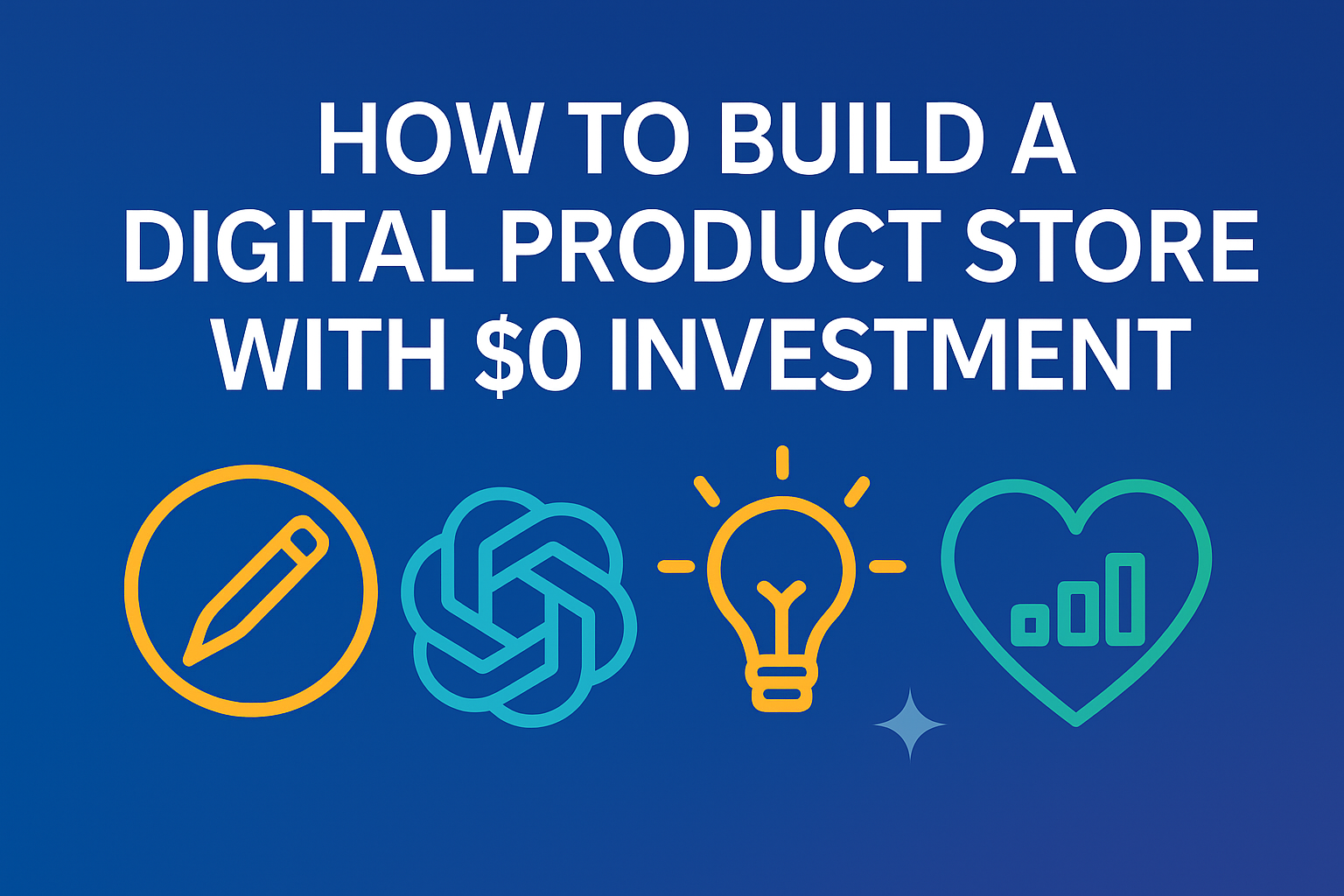Learn how to build a digital product store with $0 investment using free tools, AI resources, and smart SEO strategies. Launch your online business today with zero upfront cost.
Introduction
Are you dreaming of launching an online store but don’t have a big budget (or any budget at all)? The good news is: you can start a digital product store with $0 investment — yes, zero!
Thanks to a wide range of free tools, AI-powered resources, and SEO-driven strategies, anyone can build a professional store, upload products, attract traffic, and start earning — without touching your wallet.
In this article, we’ll walk you through everything you need to start a profitable digital product store from scratch in 2025 — using only free resources and focusing on high-traffic, low-competition strategies that rank fast.
Why Digital Products Are Perfect for Zero Investment
Before we dive into the how-to, let’s clarify why digital products are your best bet when you’re starting with no money:
-
No inventory or shipping
-
Passive income potential
-
Can be created using free tools (like Canva)
-
High profit margins
-
Global audience
Popular examples include:
-
Planners & journals
-
Canva templates
-
Lightroom presets
-
eBooks
-
AI prompt bundles
-
Notion templates
Want 500+ ideas? Grab our Free Digital Product Ideas Guide.

Free 500 Digital Product Ideas
Download Now: Free 500 Digital Product Ideas
tep 1: Choose a Niche That’s Trending & Evergreen
The best way to get fast traffic and sales is to choose a niche that’s both high in demand and easy to compete in.
Trending niches for 2025 include:
-
Etsy shop tools (mockups, planners, templates)
-
AI prompt packs (ChatGPT, Midjourney prompts)
-
Self-care & wellness journals
-
Fitness and habit trackers
-
Notion templates
-
Spiritual & manifestation printables
Explore trending freebies like Free Canva Planners and Free Lightroom Presets to inspire your niche selection.
Step 2: Create Products Using Free Tools
Here’s how to build products without spending anything:
Free Tools to Use:
-
Canva Free – Design templates, journals, planners
-
Google Docs – Create checklists, eBooks, guides
-
Notion – Build beautiful templates
-
ChatGPT (Free Version) – Generate ideas, content, and prompt packs
-
Remove.bg – Remove image backgrounds
Tip: Create bundles like “Self-Care Journal Kit” or “AI Prompt Starter Pack” to increase perceived value.
Step 3: Build Your Store with Free Platforms
There are several ways to create a free storefront:
Option 1: Gumroad (Best for Beginners)
-
100% free to start
-
Sell digital files
-
Built-in checkout and landing page
-
No need for a domain
Option 2: WordPress + Elementor (Free Hosting Options)
-
Use free hosting (like InfinityFree or 000Webhost)
-
Install WooCommerce
-
Use free themes like Astra or Hello
-
Design with Elementor free version
You can also build your store using:
-
BigCartel (free tier)
Need inspiration? Visit Pixbundle.com — a real-world example of a free digital product store setup.
Step 4: Launch on Free Marketplaces First
Instead of building a full website from day one, many successful sellers start selling on free platforms like:
-
Gumroad (free to start, great for digital products)
-
Ko-fi (ideal for creators offering downloads)
-
Payhip (handles VAT, instant setup)
-
Itch.io (good for bundles and niche items like templates or AI prompts)
These platforms allow you to validate your product before investing in custom websites, and they bring in their own audience. You can always link back to your main store later.
Example: Upload a “Digital Business Planner” to Gumroad for free and collect emails — no tech skills needed.
Step 5: Collaborate with Micro-Creators
Instead of running ads or focusing only on SEO, try collaboration marketing with small content creators and bloggers. Here’s how:
-
Reach out to YouTubers with <10K subs in the “Etsy tips” or “digital planning” niche.
-
Offer them your product bundle for free and ask for a shoutout or product walkthrough.
-
Find creators on TikTok or Instagram who create productivity or digital business content — they love Canva templates, planners, and aesthetic digital bundles.
This generates targeted exposure and backlinks that help with Google ranking too.
Step 6: Use Product Hunt & Reddit for Visibility
You can list your free digital product bundles or AI prompt packs on websites like:
This puts your free product in front of thousands of people without spending anything — and gives you high-authority backlinks.
Pro Tip: Create a “Free Resources” landing page and use it as the main link across all promotions. Google ranks resource pages faster than product pages.
Step 7: Offer Value in Niche Communities
Instead of general Facebook groups or blogs, go niche:
-
Join “Digital Planners for Moms”, “Etsy New Sellers 2025”, or “AI for Entrepreneurs” groups.
-
Share tips, not just links. For example:
“Here’s how I organize my week using a Canva editable planner. If anyone wants a free version, I’ve added it to my site.”
Value-first posts get shares, saves, and build trust — which leads to traffic that converts.
Step 8: Build a Free Community
Once you get your first 50-100 email subscribers or customers, create a private Telegram or Discord group.
Use it to:
-
Share new freebies before others
-
Run free challenges (like 7-day digital business planner challenge)
-
Ask users for feedback and ideas
This keeps people engaged without running paid ads, and helps your audience grow with word of mouth.
Final Words
You don’t need money to start a digital product store. You need strategy, creativity, and consistency.
By:
-
Starting on free platforms
-
Leveraging micro-influencers
-
Sharing in niche communities
-
Publishing unique resources

